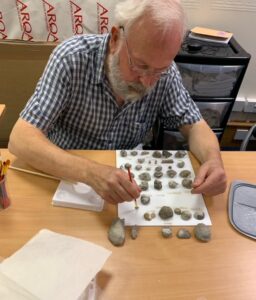This has been a busy year for the conservation of the SGS collection. I am delighted to report that there is now a team of established individuals [some members and some not] whose work towards the conservation of the collection is invaluable. The team varies in age from their early 20’s to the young 90’s. Everyone brings different skills, knowledge and talents and the work achieved is invaluable.
The SGS Collection is a Trojan horse of conservation issues. All the team are aware of the 10 agents of deterioration within objects in the museum sector. They are in no particular order:
1.Fire 
2.Water
3.Humidity
4. Light
5.Temperate
6.Pollutants
7.Pests
8.Physical force
9.Neglect
10.Theft and Vandalism
All our volunteers have undergone training and this is a recurring process. Our collection is very diverse, but over the years has suffered from recurrent pest and mould infestations to display stagnation causing some objects to become severely and irreparably light damaged. There is also the issue of the number of objects placed in over crammed storage cupboards and drawers throughout the society, as well as some of the objects on permanent display being displayed incorrectly or inappropriately. This year has seen the conservator, archivist and curator working together to identify the red and amber priority objects [see above].
The Creation of the conservation workshop in Broadgate house has been a great success.
In 2021 the conservation team has continued with the mammoth task of condition surveying the collection, to assist identification and priorities [think of a condition survey as being like a set of medical notes, to be referred throughout the object’s life).
The entire textile collection [excluding the few framed textiles still on display]. These objects have been moved to Broadgate House, quarantined, frozen to ensure eradication of pests [this became very important as there was some serious pest activity due to covid], vacuumed and any pest carcasses or casings removed, placed into appropriate storage [depending on the object this could be rolling, boxing or hanging in appropriate wrappings and materials.
From 5/10/2021 -31-12-2021 remedial treatments were completed on 59 objects. This means 59 objects were cleaned, stabilised and stored or returned to display.
From 1/1/2022 until the completion of this report on 26/6/2022 The volunteers have completed 144 objects. It is worth mentioning that 4 of the objects are cases for shells, each containing an average of some 100 shells. There has also been work on some much larger objects for example Fleet Church model, the Boar War cart, the Swedish clock and the large recently accessioned prints from the archive.
The volunteers have also built bespoke storage containers for many of the objects. This has also resulted in a huge financial saving for the society as I have calculated that if we were to have purchased Tyvec storage for our textiles we would have paid between £5-30 per item for storage. One roll costing £200 has enabled us to complete our storage, with a large quantity left for other uses. The same is true with our volunteers making in house bespoke boxes for our collection. Their skill set is evolving as they are now moving on to making custom mounts.
Work has also been carried out in coordination with the archivist in red rot [leather disease] identification and completion of two stage treatment. There has also been a start in the rehydration and unrolling and flattening of previously rolled maps and folded documents.
The work of the volunteers has enabled me to focus on some specific objects with more complex conservation requirements, these include the highway mans saddle bag, the Napoleonic prisoner of war straw boxes. I have also been able to devise an ongoing training programme of collection-based care which I personally feel should be a mandatory programme for every member and volunteer who actively handles objects and archival materials.


This may sound a lot [and it is] however, it is still part of a beginning conservation journey.
The true alchemy of the collection moving forwards will be finding the balance between securing the appropriate conservation needs of the entirety of the collection and securing the collections future. With all of the necessary changes that this will entail whilst still keeping the spirit and magic that makes the society so undeniably unique.
I would like to thank Ian, Dustin and Sharon for their help and encouragement and all the conservation volunteers from the weekly regulars, to those who come when they are able. You are a fantastic team to work with.
Finally, my thanks go to the kettle at Broadgate House, you are so useful – not just in tea making

Mary Evans
Conservator


Leave a Reply
You must be logged in to post a comment.